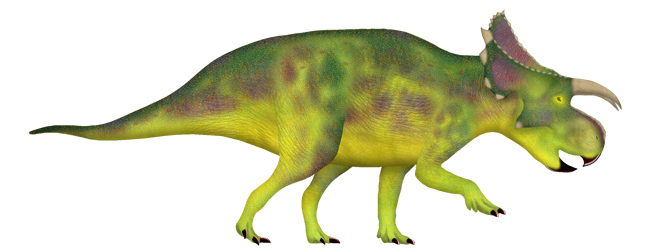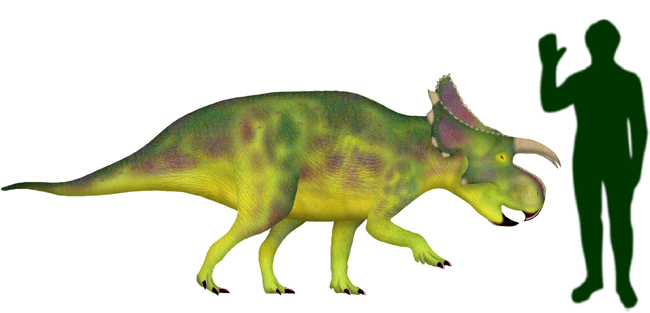The discovery of a new species of horned dinosaur from the Judith River Formation of Montana has been announced. The new dinosaur named Furcatoceratops elucidans has been assigned to the Nasutoceratopsini subfamily of the Centrosaurinae. This ceratopsian is known from a single, sub-adult specimen (holotype number NSM PV 24660). However, the nearly complete and three-dimensionally preserved bones have the potential to yield valuable data on early centrosaurines. The fossil material was first described in 2015, it was reputed to represent an Avaceratops.

Furcatoceratops elucidans
The disarticulated skeleton was collected from the upper Coal Ridge Member of the Judith River Formation. The fossil material is believed to around 75.6 million years old (Campanian faunal stage of the Late Cretaceous). Postcranial material recovered included a substantial proportion of the left side of the body, including a complete left front limb and parts of the pelvis. In addition, a significant amount of skull material was excavated.
Although the fossil specimen represents a sub-adult, researchers estimate that this herbivorous dinosaur probably reached a maximum length of around four metres. It may be possible to calculate an accurate assessment of bodyweight using circumference measurements of the left femur. Consequently, it may be possible to demonstrate that a fully grown adult Furcatoceratops would have weighed over five hundred kilograms.

A Significant Ceratopsid Fossil Discovery
The authors of the scientific paper conducted a phylogenetic assessment and concluded that F. elucidans was closely related to Nasutoceratops titusi from Utah and Avaceratops lammersi, which is also known from the Judith River Formation. Although Avaceratops lammersi was scientifically described in 1986, palaeontologists have remained uncertain with regards to classifying ceratopsid fossil material associated with other strata within the Coal Ridge Member.
The Furcatoceratops fossils will permit palaeontologists to study postcranial autapomorphies. Research on centrosaurines will be less reliant on skull fossil characteristics. Therefore, the Furcatoceratops holotype will likely be valuable for understanding previously neglected aspects of ceratopsian anatomy.
The genus translates as “forked horn face”, presumably a reference to the curved shape of the prominent brow horns. The species name comes from the Latin for “enlightening”, which reflects the significance of the holotype in terms of providing insights into ceratopsid anatomy and growth rates.
Scale Drawing and Illustration
Everything Dinosaur team members were composing a blog post about Furcatoceratops when an email was received from American artist Tim Bollinger. We checked out his DevianArt page: Total Dino Site. and discovered that he had drawn Furcatoceratops.
Tim stated:
“I love everything you are doing at Everything Dinosaur. I am a dinosaur enthusiast myself, and an aspiring palaeoartist I would love to be involved with Everything Dinosaur in any way possible.”
We explained that we get many requests such as this. However, in a bid to showcase his work, we asked and received permission to feature Tim’s illustration of Furcatoceratops in our blog post.
Everything Dinosaur acknowledges the assistance of artist Tim Bollinger in the compilation of this article.
Take a look at Tim Bollinger’s work under the moniker UnexpectedDinoLesson:
Instagram – @unexpecteddinolesson
Facebook – @UnexpectedDinoLesson
X (Twitter) – @Dino_Lesson
YouTube – @unexpecteddinolesson
The scientific paper: “Furcatoceratops elucidans, a new centrosaurine (Ornithischia: Ceratopsidae) from the upper Campanian Judith River Formation, Montana, USA” by Hiroki Ishikawa, Takanobu Tsuihiji and Makoto Manabe published in Cretaceous Research.
Visit the Everything Dinosaur website: Everything Dinosaur.






Leave A Comment